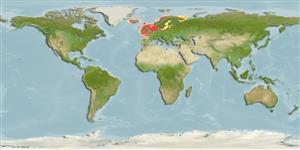Environment: milieu / climate zone / depth range / distribution range
Écologie
marin; saumâtre démersal; océanodrome (Ref. 51243); profondeur 0 - 200 m (Ref. 35388), usually 10 - 50 m (Ref. 35388). Temperate; 2°C - 15°C (Ref. 5504); 72°N - 36°N, 47°W - 45°E
Northern Sea. Reports from the Mediterranean Sea appear to be misidentifications of
P. flesus. It may have been present in some areas of the Mediterranean in the past, as a result of climatic changes related to the ice age, but at present times seem to be absent (Ref. 89040).
Length at first maturity / Taille / Poids / Âge
Maturity: Lm 32.7, range 24 - 42 cm
Max length : 100.0 cm SL mâle / non sexé; (Ref. 4705); common length : 40.0 cm TL mâle / non sexé; (Ref. 3397); poids max. publié: 7.0 kg (Ref. 173); âge max. reporté: 50 années (Ref. 173)
Épines dorsales (Total): 0; Rayons mous dorsaux (Total): 65-79; Épines anales 0; Rayons mous anaux: 48 - 59. Smooth with small scales. Bony ridge behind the eyes. Upper side brown or greenish brown with irregularly distributed bright red or orange spots. The underside is white. Lateral line straight, slightly curved above pectoral fin. Dorsal fin reaching eye. More than 30 vertebrae.
Adults live on mixed bottoms, the older the deeper the occurrence; small individuals are usually seen on bathing beaches (Ref. 9988). Occurs on mud and sand bottom from a few meters down to about 100 m, at sea, estuaries and rarely entering freshwaters (Ref. 59043). Reported as resident intertidal species with homing behavior (Ref. 32612). Feed mainly on thin-shelled mollusks and polychaetes. Batch spawner (Ref. 51846). The most important flatfish for fisheries in Europe. Utilized fresh and frozen; eaten steamed, fried, boiled, microwaved and baked (Ref. 9988). Active at night in the very shallow water while day time is spent buried in the sand. Stationary for long periods, tagging experiments have shown that their spawning migrations can be long. Changes in the environmental conditions have been disadvantageous. Populations in Kattegat and Danish belts decreased in 1980's and early 1990's due to discharge of nutritive salts. Wadden sea is still an excellent nursery ground (Ref.35388).
Adult spawn when the temperature is around 6 °C (Ref. 4705).
Vinnikov, K.A., R.C. Thomson and T.A. Munroe, 2018. Revised classification of the righteye flounders (Teleostei: Pleuronectidae) based on multilocus phylogeny with complete taxon sampling. Molecular phylogenetics and evolution, 125:147-162. (Ref. 122998)
Statut dans la liste rouge de l'IUCN (Ref. 130435)
Menace pour l'homme
Harmless
Utilisations par l'homme
Pêcheries: hautement commercial; Aquaculture: commercial; pêche sportive: oui; Aquarium: Aquariums publics
Outils
Articles particuliers
Télécharger en XML
Sources Internet
Estimates based on models
Preferred temperature (Ref.
123201): 6.8 - 12.4, mean 10.2 °C (based on 658 cells).
Phylogenetic diversity index (Ref.
82804): PD
50 = 0.6250 [Uniqueness, from 0.5 = low to 2.0 = high].
Bayesian length-weight: a=0.00776 (0.00685 - 0.00880), b=3.07 (3.03 - 3.11), in cm total length, based on LWR estimates for this species (Ref.
93245).
Niveau trophique (Ref.
69278): 3.2 ±0.3 se; based on diet studies.
Generation time: 9.2 (7.1 - 11.2) years. Estimated as median ln(3)/K based on 18
growth studies.
Résilience (Ref.
120179): Milieu, temps minimum de doublement de population : 1,4 à 4,4 années (K=0.06-0.34; tm=2-6; tmax=30; Fec=50,000).
Prior r = 0.53, 95% CL = 0.35 - 0.79, Based on 20 stock assessments.
Fishing Vulnerability (Ref.
59153): High to very high vulnerability (71 of 100).
Climate Vulnerability (Ref.
125649): Moderate vulnerability (43 of 100).
Nutrients (Ref.
124155): Calcium = 25.4 [8.2, 51.7] mg/100g; Iron = 0.202 [0.084, 0.542] mg/100g; Protein = 17.3 [15.3, 19.8] %; Omega3 = 0.249 [0.118, 0.544] g/100g; Selenium = 29.6 [10.5, 80.9] μg/100g; VitaminA = 6.73 [1.77, 26.29] μg/100g; Zinc = 0.475 [0.263, 0.968] mg/100g (wet weight); based on
nutrient studies.
